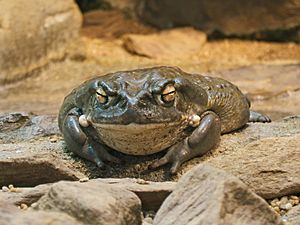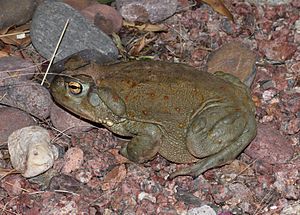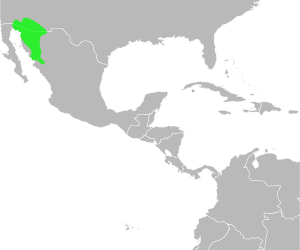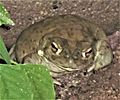Colorado River toad facts for kids
Quick facts for kids Colorado River toad |
|
|---|---|
 |
|
 |
|
| Conservation status | |
| Scientific classification | |
| Genus: |
Incilius
|
| Species: |
alvarius
|
 |
|
| Synonyms | |
|
Ollotis alvaria (Frost, 2006) |
|
The Colorado River toad (Incilius alvarius) is also known as the Sonoran Desert toad. You can find this large toad in northern Mexico and the southwestern United States.
Contents
About the Colorado River Toad
The Colorado River toad can grow to be about 7.5 inches (19 cm) long. This makes it one of the biggest toads in the United States. Only the cane toad, which is not native, is larger.
What the Toad Looks Like
This toad has smooth, leathery skin. It is usually olive green or mottled brown. Behind its large golden eye, you will see a bulging gland. This is called a parotoid gland. Below this gland is a large, pale green circle. This is its eardrum, or tympanum.
Special Glands and Sounds
Near the corner of its mouth, there is a white wart. There are also white glands on its legs. All these glands make a special liquid. This liquid is toxic, meaning it can be harmful. The toad's call is a soft, low "toot." It lasts for less than a second.
How Toads Get Water
Unlike many other animals, this toad gets most of its water through its skin. It has a special area on its belly and back legs. This area is called the "seat patch." It helps the toad quickly soak up water from small puddles or wet places.
Where the Toad Lives
The Colorado River toad lives near the lower Colorado River. It also lives in the Gila River areas. You can find it in southeastern California, New Mexico, Mexico, and much of southern Arizona.
Toad Habitats
These toads live in both desert and dry, semi-arid places. They like to be near water. You can often find them in streams, near springs, or in canals. They also live in drainage ditches and under water troughs.
Toads and Burrows
Colorado River toads sometimes use man-made water spots for breeding. These include flood control areas. They often make their homes in burrows dug by rodents. These toads are nocturnal, meaning they are active at night.
Colorado River Toad Life
The Colorado River toad shares its home with other toad types. These include the spadefoot toad, the Great Plains toad, and the red-spotted toad. Like many other toads, they actively look for food.
What Toads Eat
They eat many different things. Their diet includes insects and other small creatures. They also eat lizards, small mammals, and other amphibians.
When Toads Are Active
The toads are most active from May to September. This is because there is more rain during these months. Rain is very important for them to breed. Most Colorado River toads live for about 2 to 4 years. Other types of toads can live for 4 to 5 years.
Reproduction and Life Cycle
The breeding season for the Colorado River toad starts in May. This is when the rainy season begins. It can last until August.
Laying Eggs
Usually, one to three days after it rains, the toads start laying eggs. They lay their eggs in ponds, slow-moving streams, or temporary pools. They also use man-made places that hold water.
Toad Eggs
The eggs are small, about 1.6 millimeters wide. They are laid in a long, single tube of jelly. Each egg is about 5 to 7 centimeters apart. A female toad can lay up to 8,000 eggs at one time!
Images for kids
See also
 In Spanish: Sapo del desierto sonorense para niños
In Spanish: Sapo del desierto sonorense para niños




